Mastering Screen Recording on Lenovo Yoga Laptops
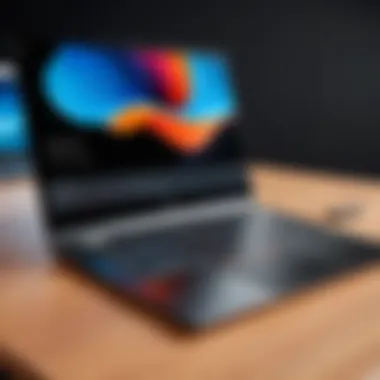
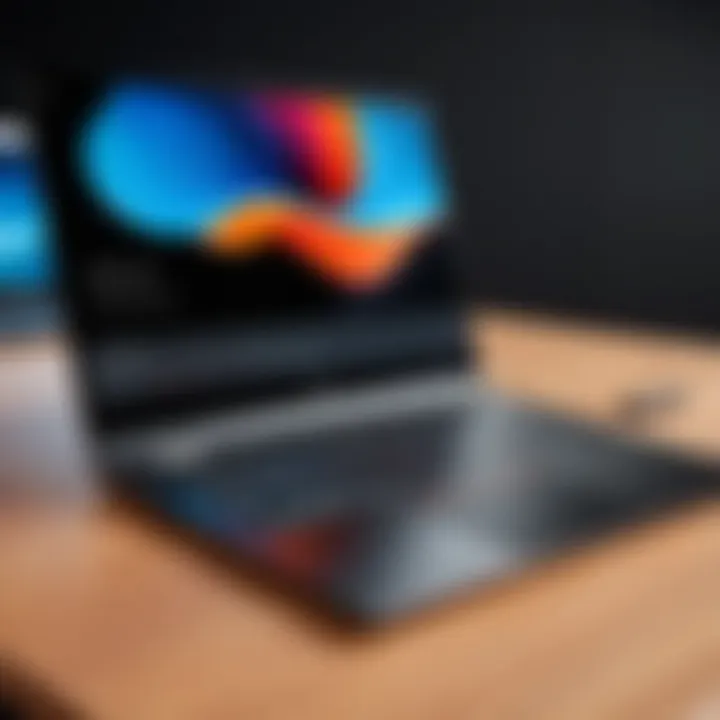
Intro
Screen recording has become an essential tool for various types of users, whether they are students, professionals, or content creators. The Lenovo Yoga laptop series, known for its versatility and performance, offers an ideal platform for capturing high-quality screen recordings. This guide aims to empower users with a step-by-step approach on how to effectively screen record on a Lenovo Yoga laptop. Moreover, it covers useful methods, tools, and settings that can enhance the recording process. By the end of this article, readers will have the knowledge necessary to navigate and utilize the screen recording functionalities on their devices.
Key Features
Design and Build Quality
The Lenovo Yoga laptop is well-regarded for its sleek design and robust build quality. When considering screen recording, the ergonomics of the device contribute to a comfortable user experience. The Yoga’s hinge allows for multiple usage modes, which can be especially useful when setting up for a recording session. Users can adjust the angle for optimal visibility and comfort, making it easier to interact with the screen while recording.
Display and Performance
The display of a Lenovo Yoga laptop is another significant feature that enhances screen recording capabilities. With options for high-resolution screens, the visual clarity during recordings is excellent. Additionally, the performance of the device, powered by advanced processors and adequate RAM, ensures that running screen recording software does not hinder other tasks. This ensures smooth functionality and high-quality output for screen recordings.
Product Specifications
Technical Specifications
Understanding the technical specifications of your Lenovo Yoga laptop can optimize your screen recording experience. Most models come equipped with the following:
- Intel Core processors
- Minimum of 8GB RAM
- SSD storage options for fast performance
These specifications facilitate effective multitasking and allow for smooth performance while recording.
Compatibility and Connectivity
Lenovo Yoga laptops generally feature several connectivity options including USB-C ports, HDMI output, and Wi-Fi capabilities. These features not only support various screen recording tools but also allow for easy sharing of the recorded material. It is essential to consider compatibility with popular screen recording applications like OBS Studio, Bandicam, or Microsoft’s built-in screen recording tool.
Ensure that your Lenovo Yoga laptop is updated regularly. This can improve compatibility with screen recording software, reducing potential issues during capturing.
Culmination
Understanding Screen Recording
Screen recording is becoming an essential skill in today’s digital landscape. This article highlights various aspects of screen recording, especially for those using Lenovo Yoga laptops. Understanding the methods and tools available can significantly enhance one’s productivity and creativity.
One critically important element of screen recording is its ability to capture visual content directly from the screen. This can be utilized for different purposes, such as creating tutorials, sharing gameplay, or documenting software bugs. Knowing how to effectively record your screen allows users to communicate ideas and instructions more clearly. Moreover, having screen recordings can help in retaining information and improving learning outcomes.
Definition and Purpose
Screen recording refers to the process of capturing the actions occurring on a screen, typically accompanied by audio. The primary purpose is to create visual content that can be shared with others or stored for future reference. It differs from regular video recording as it specifically targets what is happening on a computer or mobile screen.
Understanding the purpose of screen recording is crucial. It can serve multiple avenues:
- Educational Resources: Instructors can create lecture recordings, making the learning material accessible to a broader audience.
- Professional Communication: Teams can record presentations or software demonstrations, ensuring that all members are aligned.
- Gaming: Gamers often record gameplay to share skills, highlight achievements, or create engaging content.
Common Use Cases
There are various scenarios where screen recording proves to be beneficial. Familiarity with these use cases can better inform users about when and how to employ screen recording.
- Tutorials and Walkthroughs: Many content creators produce step-by-step guides to educate audiences on using specific applications or performing tasks on the computer.
- Software Testing: Developers and testers can capture bugs in action, which simplifies the reporting process.
- Webinars and Meetings: Recording these sessions allows participants to revisit crucial points discussed, which is especially helpful for those unable to attend in real time.
- Social Sharing: Individuals may want to share snippets of their screen activity on platforms like Facebook or Reddit. This could range from gameplay to special projects.
"Having the skill to effectively record your screen enables one to harness visual communication in a powerful way."
In summary, understanding the significant role of screen recording can empower users, especially those employing Lenovo Yoga laptops, to maximize their devices' capabilities and enhance both their professional and personal projects.
Overview of Lenovo Yoga Laptop Features
Understanding the features of the Lenovo Yoga laptop is crucial for anyone looking to effectively screen record. This device combines innovation with functionality, making it a suitable choice for various tasks including screen recording. The Yoga series is known for its versatility, allowing users to utilize the laptop in different modes such as laptop, tent, and stand mode. This flexibility can enhance the screen recording experience by providing a comfortable setup based on the user's needs.
Hardware Specifications
The Lenovo Yoga laptops are equipped with hardware that supports efficient screen recording. They often come with powerful processors, such as Intel Core i5 or i7, which ensure smooth performance during recording sessions. A standard configuration also includes ample RAM, typically 8GB or more, allowing users to run multiple applications without hindrance.
Additionally, the high-resolution displays, often Full HD or 4K, provide clarity when capturing detailed content onscreen. The presence of integrated graphics or dedicated GPUs further enhances the laptop's capability to handle video rendering tasks, which is essential when creating high-quality screen recordings. The Yoga laptops also feature sensitive touch screens, adding another layer of interaction that can be beneficial during the recording process.

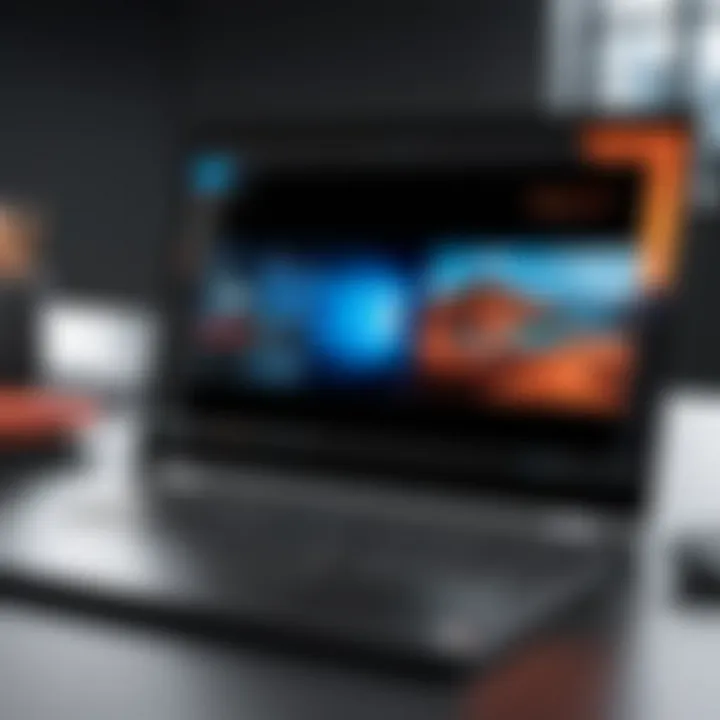
Operating System Compatibility
The Lenovo Yoga series predominantly runs on Windows operating systems, frequently shipping with Windows 10 or the latest version at the time of purchase. Windows 10 offers built-in functionality for screen recording, such as the Windows Game Bar, which allows immediate access to recording features at the touch of a button. This makes it user-friendly for both beginners and advanced users alike.
Moreover, it’s essential to note that not all versions of Windows support the same features, so ensuring compatibility is vital. Users should check for any system updates that might provide enhancements or new features relevant to screen recording. For instance, Windows 11 offers improved capabilities, making it an attractive option for users seeking newer functionalities.
Built-in Screen Recording Options
Built-in screen recording options on your Lenovo Yoga laptop play a significant role in simplifying the recording process. These features usually come pre-installed with the operating system. They serve as a time-saving solution for users who might not want to deal with third-party software complexities. Additionally, using built-in options can help minimize resource consumption compared to external software, making them great choices for casual recordings as well as more professional scenarios.
Benefits of Built-in Screen Recording Options:
- No Additional Downloads: You do not need to search for and install separate programs. The tools are readily available.
- Integrated with the Operating System: This offers better performance and stability, reducing the risk of glitches and crashes.
- Easy Access: These tools are designed to be user-friendly, allowing even the less tech-savvy individuals to start recording efficiently.
However, it is essential to understand the limitations of these built-in tools to make informed choices when recording. While they are generally effective for basic tasks, advanced features and customization may still require external software.
Windows Game Bar
The Windows Game Bar is a popular built-in option for screen recording on Lenovo Yoga laptops. It was initially designed for gamers but quickly became a useful tool for anyone needing to capture screen activity. You can access it by pressing Windows Key + G during an active window.
Key Features of Windows Game Bar:
- Easy Activation: Simple keyboard shortcuts make it quick to start or stop recordings.
- Audio Control: Users can manage audio inputs and outputs, allowing for voice narration or game audio recording.
- Performance Metrics: Users can view frame rates and system performance, useful for those interested in optimizing recording conditions.
To get started with Windows Game Bar:
- Open the application or window you want to record.
- Press Windows Key + G to bring up the Game Bar interface.
- Click on the Record button or press Windows Key + Alt + R to start recording.
- Once finished, use Windows Key + Alt + R again to stop the recording.
- The recordings are automatically saved in the Videos folder under Captures.
One limitation is that Windows Game Bar does not allow you to record desktop activity directly. It is primarily intended for applications and games, leaving desktop captures to other tools.
Using Snipping Tool
The Snipping Tool provides another built-in method for recording your screen on a Lenovo Yoga laptop, particularly for capturing still images of your screen. This tool is available in older Windows versions but replaced by the Snip & Sketch tool in later updates. However, both functions are similar in purpose.
How the Snipping Tool Works:
- The focus is on capturing specific areas or windows. It does not offer full video recording.
- It is perfect for users who need to highlight particular elements on their screen without needing full-motion capture.
Steps to Use Snipping Tool:
- Search for Snipping Tool in the start menu and open it.
- Choose the type of snip you want: free-form, rectangular, window, or full-screen.
- Click on New to start the capture process.
- Capture the desired area and save it easily.
While this tool is invaluable for screenshots, remember it does not provide video recording capabilities. It is best employed alongside other recording options when you only need still images.
Conclusion: Both the Windows Game Bar and Snipping Tool offer valuable options for screen recording and capturing. While they cater to different needs, understanding their functionalities can greatly enhance your overall recording experience.
Third-Party Screen Recording Software
Third-party screen recording software plays an essential role in enhancing the screen-capturing experience on a Lenovo Yoga laptop. While built-in options such as the Windows Game Bar offer basic functionalities, third-party applications often provide advanced features that cater to more specific needs. This includes customizable recording settings, editing capabilities, and support for various output formats. For those looking to create high-quality tutorials, gameplay recordings, or professional presentations, third-party software is often the preferred choice.
Some notable advantages of using third-party applications include:
- Increased Flexibility: Users can tailor their recording setups more precisely according to their requirements.
- Enhanced Features: Advanced editing tools allow for a more polished final product, such as adding text overlays or transitions.
- Support for Different Formats: The ability to export recordings into various codecs and resolutions enhances compatibility with different devices and platforms.
However, there are considerations to keep in mind. The installation process, compatibility with the operating system, and potential costs are pertinent factors to evaluate when selecting a screen recorder. Ensuring that the chosen software aligns well with the specific requirements of the user's projects is vital for achieving the best results.
Popular Software Options
When it comes to selecting third-party software for screen recording, several options stand out for their performance and usability:
- OBS Studio: Open Broadcaster Software is widely recognized for its versatility and is especially popular among gamers and streamers. Its ability to support multiple sources and scenes makes it powerful for professional recordings.
- Camtasia: This software offers robust editing tools alongside screen recording, making it ideal for creating professional tutorials and presentations. Users can easily trim clips, add annotations, or include background music.
- Bandicam: Known for its high-quality recordings, Bandicam allows users to record in 4K quality. It's particularly favored for capturing gameplay, as it minimizes lag and retains detail.
- Snagit: This software is simple, focusing on screen captures, highlighting, and quick edits. It's great for creating straightforward how-to guides or sharing information visually without much hassle.
Installation and Setup
The installation and setup process for third-party screen recording software is usually straightforward, but it can vary based on the application chosen. Here’s a general guideline to follow:
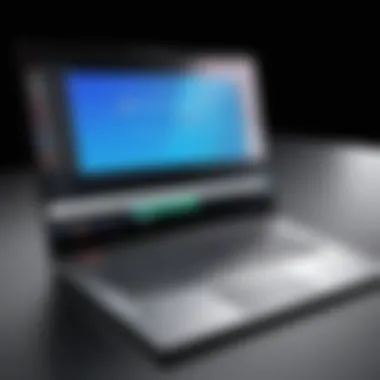
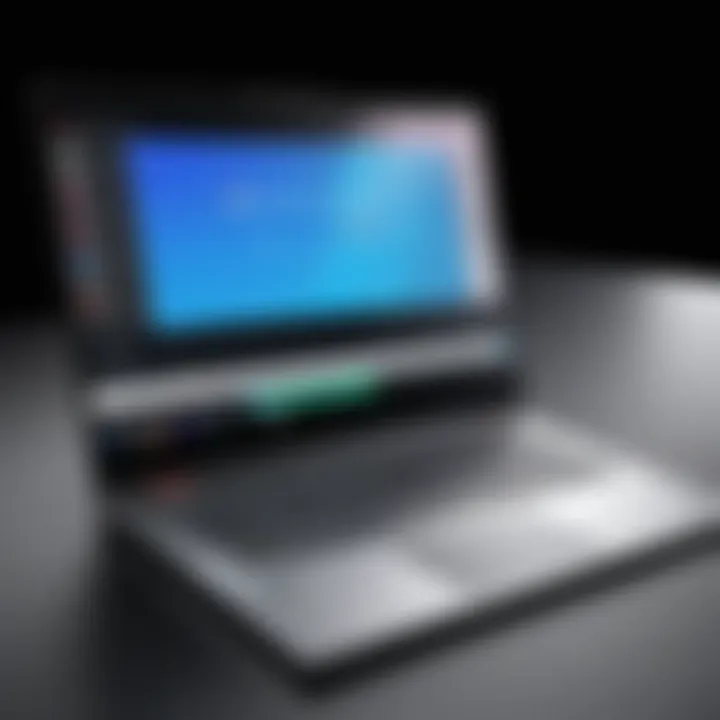
- Download Software: Visit the official website of the chosen software to ensure a secure download. Avoid third-party sites to prevent malware risks.
- Run the Installer: Open the downloaded file and follow the on-screen instructions to install the software on your Lenovo Yoga laptop.
- Configure Settings: After installation, launch the software and configure your settings. This includes selecting audio sources, video quality, and frame rates.
- Testing: It is often wise to create a short test recording to evaluate the performance and make adjustments as necessary. This step helps to ensure that everything is functioning correctly before starting your main recording projects.
Good software can greatly enhance your recording experience, but take time to learn its features before diving into larger projects.
By understanding the intricacies of different third-party software options and their installation processes, users can significantly elevate their screen recording experience.
Step-By-Step Guide to Screen Recording
Screen recording is a valuable skill, particularly for users of the Lenovo Yoga laptop. Knowing how to capture your screen effectively can enhance presentations, facilitate online tutoring, or simply allow sharing of gaming moments. This section provides a structured approach to screen recording, ensuring users can navigate the process with confidence. Here, we will discuss choosing the right recording method, configuring essential audio and video settings, starting the recording, and finally stopping and saving the recorded content.
Choosing the Right Recording Method
Selecting the correct recording method is crucial. Users can opt for built-in options provided by the Lenovo Yoga laptop or third-party software. The Windows Game Bar is a popular tool for gaming and casual recordings. It is easy to access and requires no additional installation. Alternatively, tools such as OBS Studio or Camtasia offer advanced features, suitable for content creators needing more control over their recordings. Consider your needs when making this selection.
A well-chosen recording method can make or break the quality of your final output.
Configuring Audio and Video Settings
Once the recording method is chosen, configuring audio and video settings becomes imperative. Users should ensure the resolution is set to match their display capabilities. Higher resolutions yield better quality but may increase file size. Users must also check audio sources. For instance, selecting the proper microphone ensures clear narration. In Windows, the audio settings can be adjusted easily from the recording tool's interface. Take time to test these settings before starting the actual recording.
Starting the Recording Process
After configuring the settings, it is time to start recording. With the chosen tool open and the desired screen ready, users should initiate the recording by pressing the designated shortcut or button on the interface. For Windows Game Bar, the standard shortcut is Windows + G, followed by a click on the record button. A countdown may appear, indicating the beginning of the recording. It is useful to practice speaking clearly and positioning the cursor as needed during the recording. This gives a smooth flow to the content captured.
Stopping and Saving the Recording
Finishing the screen recording process requires careful attention. Once done, users should stop the recording by pressing the stop button or using the keyboard shortcut. After stopping, the software usually offers options to save the recording. Choosing a relevant file format is essential; formats like MP4 are widely compatible and provide good quality. Additionally, naming the file appropriately can assist in organizing recorded content for future access.
In summary, this guide aims to prepare the user for a seamless screen recording experience on a Lenovo Yoga laptop. Careful consideration of the recording method, attention to settings, and proper organization of saved files are key factors for success. With these steps, users can achieve high-quality recordings suitable for various purposes.
Editing Screen Recordings
Editing screen recordings enhances the final product by improving clarity and professionalism. The process of recording is only the first step; the editing phase allows creators to refine their content, make it more engaging, and ensure that it effectively communicates the intended message. In an era where digital content is abundant, having polished recordings can distinguish one’s work from others.
Editing not only allows for the removal of unnecessary segments but also facilitates the addition of elements like captions, images, or annotations that can significantly enhance viewer understanding. This process ensures that all recorded material aligns with the overall narrative and purpose of the recording.
For the tech-savvy audience using Lenovo Yoga laptops, understanding editing tools available for refining screen recordings is crucial. Familiarity with basic features as well as advanced tools empowers users to craft high-quality content that captures attention and conveys information effectively.
Basic Editing Features
Basic editing features are essential for quick adjustments and enhancements. Typical tools available in many video editing programs include:
- Trim and Cut: Users can eliminate unwanted sections of the recording to focus on the most pertinent content. This feature is fundamental for maintaining viewer engagement.
- Audio Adjustment: Users can adjust volume levels and remove background noise. Clear audio is vital for effective communication, so this feature is particularly important.
- Text Overlays: Adding text annotations allows for clarification or emphasis on critical points. This is useful for guiding viewers or highlighting specific information.
- Splitting Clips: Users can divide recordings into smaller sections, making it easier to rearrange footage for better flow.
These basic features are often user-friendly and require minimal experience, making them accessible for beginners while still beneficial for more experienced users.
Advanced Editing Tools
For those looking to take their screen recordings to another level, advanced editing tools provide additional capabilities. These include:
- Multi-layer Editing: This offers the ability to work with multiple video or audio tracks, allowing for more complex productions. Users can combine recordings, add voiceovers, or overlay background music seamlessly.
- Special Effects: Some editing software allows users to incorporate transitions, filters, and effects that can make a recording visually more appealing. This can capture viewer interest and enhance the overall viewing experience.
- Color Correction: Adjusting colors improves video quality and can create a more professional feel. Proper color grading enhances visual consistency, which is crucial when the recording contains diverse visual elements.
- Zoom and Pan Effects: These effects direct the viewer's attention to specific areas of the screen, making the content more engaging and informative. By focusing on key components, viewers can grasp complex information quickly.
By utilizing both basic and advanced editing tools, users can maximize the effectiveness of their screen recordings, ensuring they not only inform but also captivate their audience. The editing phase is where the raw recording is transformed into a refined piece of content, ready for sharing and discussion.
Sharing Screen Recorded Content
Sharing screen recorded content is a crucial step in the process of capturing and utilizing your recordings effectively. Once you've recorded your screen on a Lenovo Yoga laptop, the next logical phase involves distributing that content to your intended audience. This can range from colleagues and clients in a professional context to friends and followers in a more casual setting.
When you share your screen recordings, you open up avenues for collaboration, education, and communication. It allows you to showcase presentations, tutorials, or even software demonstrations. The ability to distribute this content efficiently can greatly enhance the impact and reach of your work. Therefore, understanding the options at your disposal is vital to maximizing the potential of your recordings. Furthermore, considering factors such as file size, format, and audience preference will ensure your recordings are both accessible and engaging.
Exporting Options
Exporting your screen recordings in the appropriate format is essential for ensuring compatibility with various devices and platforms. Most recording tools provide several export options. Here are some common formats to consider:
- MP4: Widely supported across platforms, ideal for general use.
- AVI: Suitable for high-quality video but might result in larger file sizes.
- GIF: Good for short clips, commonly used for quick demonstrations on social media.
- WMV: Preferred for Windows applications but less compatible with non-Windows systems.
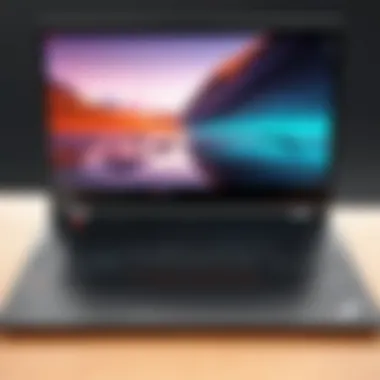
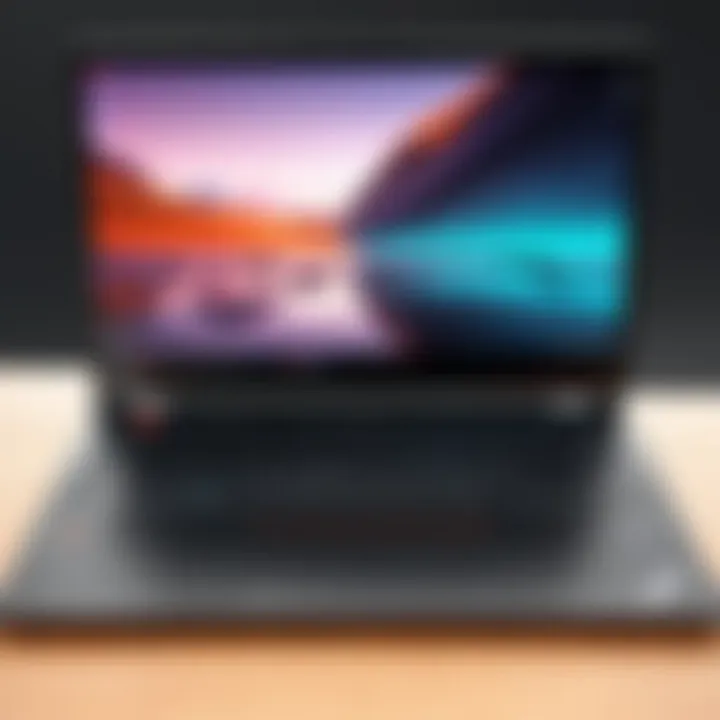
When exporting, consider not only the format but also the resolution and bitrate. Higher resolution offers better quality, but larger file sizes could complicate sharing. Choose the format that best serves your content’s purpose.
Platforms for Sharing
After exporting, the next step is to choose the right platform to share your screen recordings. Different platforms cater to varied audiences and purposes. Here are some popular options:
- YouTube: Great for reaching a large audience and ideal for tutorials or reviews. You can leverage its search functionalities to enhance discoverability.
- Vimeo: Offers high-quality video hosting with customization options, suitable for professional presentations.
- Social Media: Platforms like Facebook, Instagram, and Twitter allow for easy sharing with personal networks or targeted audiences. Shorter clips can be particularly engaging.
- Cloud Services: Google Drive, Dropbox, or OneDrive help in sharing files directly, especially for larger recordings that might be cumbersome to send through email.
- Professional Sites: For business content, consider platforms like LinkedIn where you can connect with other professionals.
Each platform comes with its own set of advantages and limitations; knowing your audience can guide your choice.
"Choosing the right platform is as important as the content itself. Consider your audience and the message you wish to convey."
Troubleshooting Common Issues
Screen recording on a Lenovo Yoga laptop can be a straightforward process, but challenges may arise. Addressing common issues is crucial for maintaining a smooth user experience. Knowing how to troubleshoot effectively can save time and enhance the quality of the recordings. This section explores typical problems users may face during screen recording and provides solutions to resolve them.
Audio Problems
Audio issues during screen recording can significantly impact the usability of the recorded content. Users may experience problems such as no sound, distorted audio, or low volume.
Here are some steps to troubleshoot audio problems:
- Ensure the microphone is enabled in the audio settings of your laptop.
- Check volume levels on both the system and recording software.
- If an external microphone is used, verify that it is correctly connected and selected in the audio settings.
- Test the audio input before starting the recording.
Resolving these issues often requires simple adjustments in system settings or software configurations, but identifying the source of the problem is essential.
Video Quality Issues
Video quality is another area that could present challenges during recording. Users may notice issues such as pixelation, lag, or low frame rates. These factors can detract from the clarity and professionalism of the content. To address video quality concerns:
- Try lowering the resolution settings for smoother performance.
- Ensure that other applications are closed to free up system resources.
- Update the graphics drivers on the laptop to improve performance.
- Adjust screen recording software settings to balance quality and system capability.
Consistent troubleshooting in this area can lead to improved video output, drastically enhancing the viewing experience for the audience.
Software Compatibility Concerns
The choice of screen recording software can sometimes lead to compatibility issues with the Windows operating system or laptop hardware. Problems may manifest as application crashes, inability to record, or features not functioning correctly. Users should take the following steps:
- Verify system requirements of the recording software.
- Keep all software updated to the latest versions.
- Consider trying alternative screen recording tools that may be more compatible with the Lenovo Yoga series.
- Consult community forums, such as Reddit, for user experiences and recommendations.
Incompatibility can often be mitigated with simple updates or by exploring different software solutions, ensuring users have a reliable recording experience.
Best Practices for Effective Screen Recording
Effective screen recording is essential for creating high-quality content that communicates a clear message. This not only improves the overall viewer experience but also enhances the quality of the information being shared. Adhering to best practices can significantly impact the success of screen recordings, especially for those utilizing a Lenovo Yoga laptop where features and tools are readily available.
Preparing Your Workspace
A well-organized workspace plays a crucial role in ensuring an efficient screen recording session. Start by minimizing digital clutter; close unnecessary applications and tabs that could distract viewers or impact your laptop's performance. Ensure that your desktop is clean, and remove any sensitive information that you do not want recorded.
Physical environment matters too. Choose a quiet room to avoid background noises. This not only makes the recording sound more professional but also helps in maintaining viewer focus on the content being presented. Positioning your Lenovo Yoga laptop at eye level is also important for comfort during long recording sessions. You should ensure your webcam, if used, is at an angle that flatters you since this can enhance viewer perception.
Maintaining Clear Audio
Audio clarity can be the defining factor of a successful screen recording. If the listener is unable to hear the narration clearly, they may disengage from the content. Invest in a quality microphone that reduces background noise. This improvement can be significant, as built-in microphones often pick up unwanted sounds from the environment.
Before starting the recording, check your audio settings and volume levels. Conduct a test recording to ensure there are no audio distortions. Monitoring your audio during the recording is also advisable. Use headphones to catch any potential issues as they arise. If your recording software includes an option to capture system sounds, be sure to adjust these settings to balance both your voice and the sounds from your screen.
By paying attention to your workspace and audio quality, you increase the overall professionalism of your recordings and enhance the viewing experience for your audience.
Following these best practices will lead to high-quality screen recordings, ensuring your message is effectively communicated while keeping your audience engaged. It's important to revisit these elements during each recording to continually refine the process.
The End
The conclusion of this article emphasizes the critical aspects of screen recording on a Lenovo Yoga laptop. Screen recording serves a multitude of purposes, whether for professional presentations, gaming highlights, instructional videos, or personal projects. Its importance lies not just in the ability to capture visual information, but in how effectively it can communicate complex ideas and foster collaboration.
Summary and Final Thoughts
In summary, mastering screen recording on your Lenovo Yoga allows for a dynamic way to share knowledge and creativity. This guide has covered various tools and methods, including both built-in options and third-party software. Each of these solutions offers distinct advantages depending on user requirements and technical familiarity. By ensuring you have configured both audio and video settings correctly, you can enhance your recordings significantly. Furthermore, knowing how to edit and share your content amplifies the impact of your work. It transforms recordings from mere files into engaging visual narratives.
Encouragement for Innovation
Finally, the innovation surrounding screen recording technology continues to expand. As a tech-savvy individual, you should embrace the evolving tools and techniques available. Experiment with different software and methods to find what best suits your unique needs. By doing so, not only will you improve your recording quality, but you'll also contribute to the creative community. Integrating your unique style with effective screen recording practices can lead to groundbreaking content creation.



